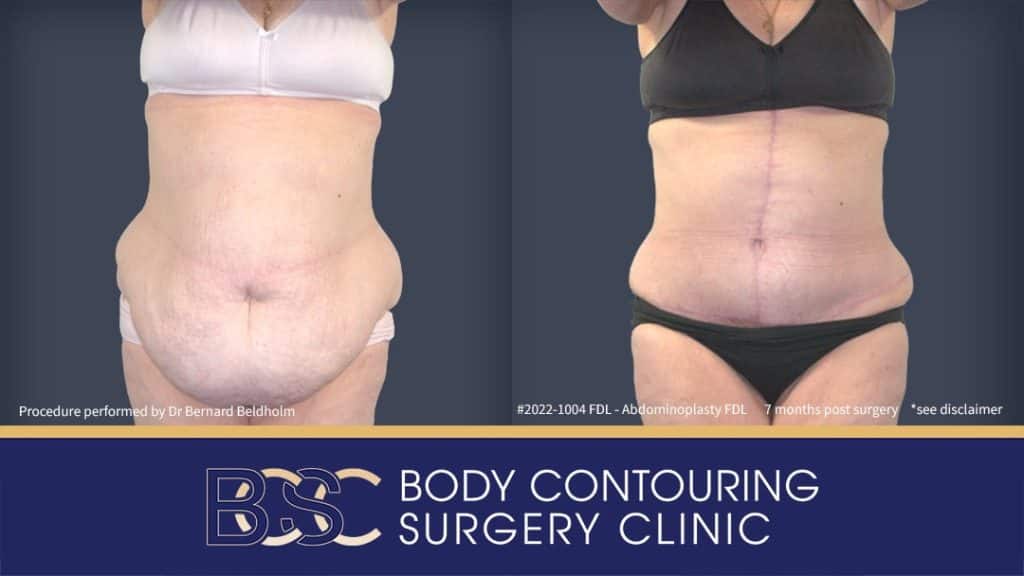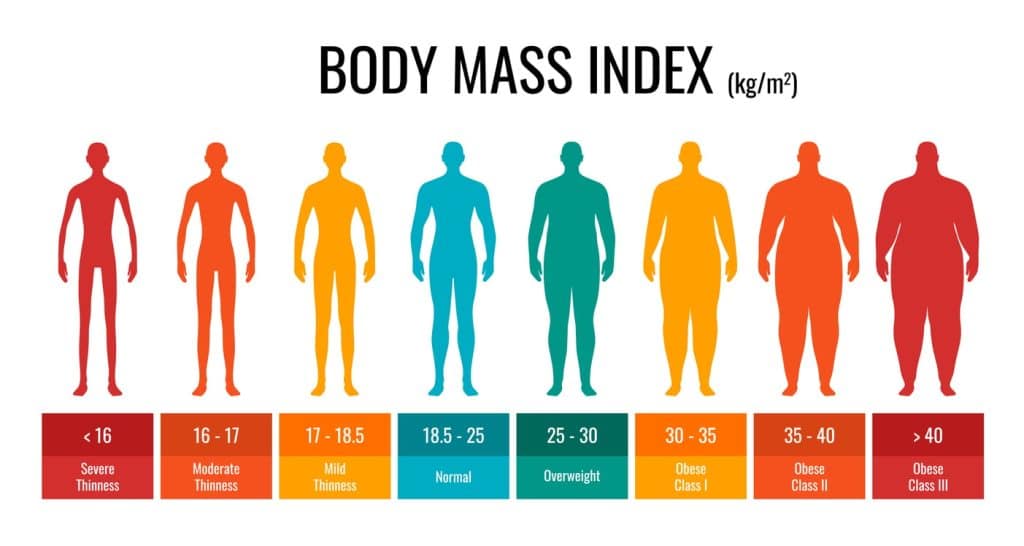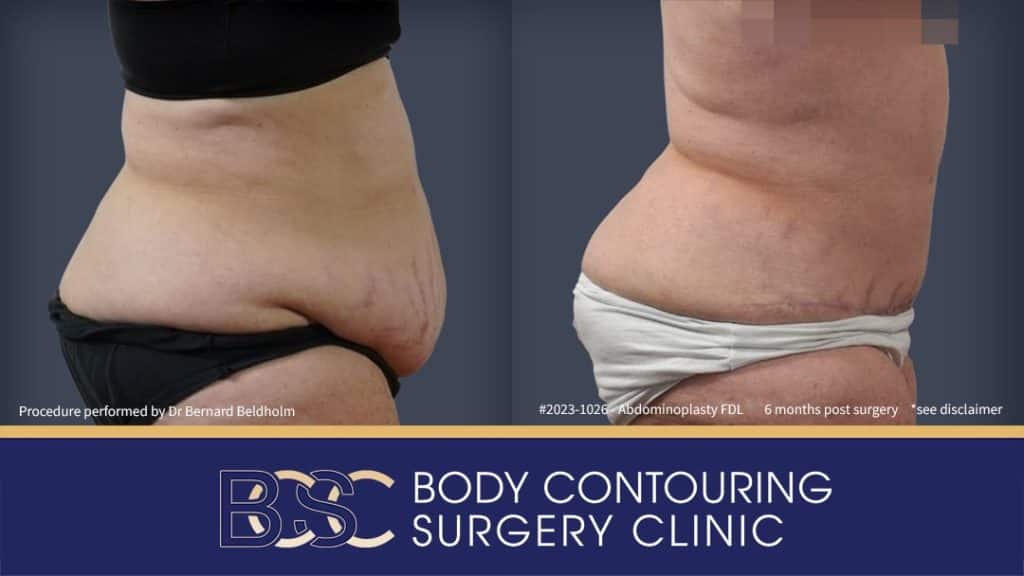Regaining Weight After Fleur-de-Lis Abdominoplasty
Gaining weight after Fleur-de-lis abdominoplasty can impact the procedure’s results. Therefore, it’s recommended to maintain a stable weight after weight loss surgery.
A Fleur-de-lis abdominoplasty is a surgical procedure that removes excess, loose skin from the lower and upper abdomen. It also involves repairing any weakened or separated abdominal muscles. The results of this procedure are long-lasting, but gaining weight after the surgery can impact the results. Significant weight gain can cause the abdominal skin and muscles to stretch again.
If there is a significant fluctuation in weight, it can have serious consequences and may require revision surgery. Therefore, it is important to maintain a stable weight after Fleur-de-lis surgery. In this guide, we will discuss in detail the consequences of regaining weight after Fleur-de-lis surgery and how you can minimize the risk of weight regain.

- Fleur de lis abdominoplasty after significant weight loss | Dr Beldholm
Disclaimer: Operation performed by Dr Bernard Beldholm. Adult content, surgery has risks; individual results vary, seek 2nd opinion. Please see the full disclaimer.
Ramifications of Re-Gaining Weight After FDL Surgery
It’s important to note that removing excess, loose skin and excess tissue will not prevent weight gain in the future. Therefore, you should maintain your ideal weight after undergoing Fleur-de-Lis surgery.
Gaining a few kilograms will not affect your results. However It takes significant weight gain to affect your FDL payoff. Too much weight gain will re-stretch the abdominal skin and likely cause muscles to separate. Determining the amount of weight gain that is “too much,” however, is a challenge since it depends on individual factors. Most specialist surgeons consider a weight gain of approximately 10 kilograms as a significant weight gain likely to affect the procedure’s results.

- BMI
Weight gain will not only lead to loss of the achieved aesthetics, but it can also lead to complications. These effects can be severe and can lead to revision of the fleur de lis abdominoplasty. It’s important to note that revision surgery can be much riskier than the initial surgery. For these reasons, Dr Beldholm stresses the importance of maintaining a healthy lifestyle after body contouring surgery.
Let’s analyse some of the consequences of regaining weight after Fleur-de-lis surgery.
Stretched Skin and Muscle

- Before and after
Nipple-areola covered to comply with No nudity
Disclaimer: Operation performed by Dr Bernard Beldholm. Adult content, surgery has risks; individual results vary, seek 2nd opinion. Please see the full disclaimer.
During surgery, the specialist surgeon will remove excess, hanging skin and fat from the abdomen, and then stretch the remaining skin, giving you a contoured shape. In addition, the specialist surgeon will repair any separated abdominal muscles during the procedure.
Most Fleur-de-lis clients are massive weight loss patients with loose, excess skin and separated abdominal muscles. Regaining weight after Fleur-de-lis abdominoplasty may result in the loss of the contoured abdominal skin due to stretching. Additionally, an increase in weight may exert pressure on the repaired abdominal muscles causing them to re-separate.
Fat Accumulation
If there is excess subcutaneous fat, the surgeon can remove the accumulated fat in the abdominal region to give the abdomen a contoured shape. Dr. Beldholm incorporates VASER liposuction into his body contouring procedures to effectively remove excess fat. Weight gain can cause fat to accumulate again, eventually resulting in loose abdominal skin.
Altered Surgical Procedure Results
The goal of undergoing Fleur-de-lis abdominoplasty is to remove loose, lax skin and excess fat in the abdominal region. One major effect of regaining weight after Fleur-de-lis surgery is the adverse effects on surgical results. Significant weight gain results in fat accumulation and recurrence of loose abdominal skin. Regaining weight after the procedure can reverse the results and increase the risk of complications.
Increased Risk of Complications
Some complications resulting from significant weight gain, such as hernia and diastasis recti, stem from weakened abdominal muscles. Hernia is the occurrence of a protrusion on the skin due to the abdominal organs pushing through weakened abdominal muscles, while diastasis recti is separation of abdominal muscles due to weakness.
Abnormal Scarring
Fleur-de-lis abdominoplasty involves two incisions, one running horizontally (from hip-to-hip) and another running vertically (from the pelvis to the sternum). The incisions result in an inverted T-shaped scar (horizontal and vertical scar). Regaining weight after Fleur-de-lis abdominoplasty will stretch the scar, which can have an unpleasant appearance, potentially requiring scar revision surgery. can necessitate scar revision.
A study on scar revision after abdominoplasty notes, “…many scar revision techniques have been described including excision and direct closure, dermis enhancement (dermal tube, double-breasting, and dermal graft), local flaps (Z-plasty, W-plasty, and other variants), fillers and tissue expansion.”
General Health Risks
Regaining weight after Fleur-de-lis abdominoplasty can affect the patient’s general health. Some of the health concerns stemming from significant weight gain include cardiovascular diseases, diabetes, and joint problems.
These health problems, coupled with surgical risks resulting from Fleur-de-lis abdominoplasty, may be detrimental to your health. Additionally, general health risks like diabetes may result in the occurrence of secondary health problems.
Impact on Mobility and Activity Levels
Significant weight gain can greatly affect an individual’s functionality. Mobility, which is essential in carrying out daily activities, decreases significantly. Significant weight gain also leads to loss of stamina and fatigue after small tasks, makes exercise difficult, and increases the inability to perform certain job requirements, ultimately impacting one’s earning potential.
Long-Term Effects
Regaining weight after Fleur-de-lis abdominoplasty can have long-term effects that can cause detriment to one’s physical and psychological health. These can range from abnormal scars to cardiovascular concerns.
How Pregnancy Weight Gain Can Impact Results of FDL Surgery
Though it is possible to get pregnant after undergoing Fleur-de-lis abdominoplasty, Dr Beldholm recommends that patients wait until they have finished having children before undergoing the procedure.
The main reasons you should avoid pregnancy after Fleur-de-lis surgery are the implications they may have on the results and the risk of potential complications. Most women gain a significant amount of weight during pregnancy; stretching the abdominal skin and muscles. Some women’s skin may retract back to its original size depending on individual factors. However, many women will experience loose skin after pregnancy, which can negatively impact the results of Fleur-de-lis surgery.
In addition to occurrence of loose abdominal skin, pregnancy after Fleur-de-lis surgery may lead to:
- Diastasis recti recurrence.
- Recurrence of hernia.
- Impact on the scars, causing them to stretch, widen, or change in colour or texture, making them more prominent.
- Changes in fat distribution and accumulation around the abdominal region and other body regions.
A study on pregnancy after abdominoplasty notes, “A survey of 32 patients with a previous history of abdominoplasty surgery showed compromised aesthetic outcomes after pregnancy, including new stretch marks, widened scar, excess skin, and abdominal protrusion.”
How to Minimise Risk of Regaining Weight
Regaining weight after Fleur-de-lis abdominoplasty has numerous consequences, which can necessitate revision abdominoplasty. As noted, revision abdominoplasty is riskier than the initial procedure. Therefore, according to Dr Bernard Beldholm, the priority of patients who have undergone Fleur-de-lis abdominoplasty should be minimising the risk of regaining weight.
Below are ways to ensure you maintain your ideal weight after Fleur-de-lis surgery.
Balanced Diet
Following a balanced and healthy diet is a key to maintaining a stable weight after Fleur-de-lis tummy tuck procedure. Eat nutritionally-dense foods, limit processed products and watch your portions. Additionally, always stay hydrated. If necessary, your surgeon may recommend that you seek help from a nutritionist to keep your diet and health in check.
Regular Exercise
Exercise helps to ensure the body remains fit and is essential in maintaining the abdominal contour achieved following Fleur-de-lis surgery. Be sure to include cardio and strength training in your workout. The most important thing to remember is that consistent exercise is what will keep you fit without gaining the weight back.
However, avoid exercising immediately after surgery; instead, try to ease into the routine. Also, avoid exercises that can put a lot of pressure on the core before full recovery. You must also take slow steps in your journey of exercising and take breaks at regular intervals and whenever you feel that you are straining your abs.
Monitor Your Weight
Instead of waiting to hop on the scale when you suspect you have gained weight, weigh yourself regularly and keep a record. This way, you can stay on top of the numbers and take applicable measures before it’s too late.
Healthy Lifestyle Choices
Unhealthy living is one of the significant causes of these weight increases. As a result, Dr Beldholm emphasises making healthy lifestyle choices after Fleur-de-Lis procedure. This includes observing good sleeping habits, avoiding tobacco, staying hydrated, limiting alcohol intake, and eating a well-balanced diet, among other measures. Adopting healthy habits helps to maintain a healthy weight following Fleur-de-Lis surgery.
Follow Post-Operative Guidelines
After Fleur-de-Lis surgery, your specialist surgeon will give you a list of guidelines that you should follow after the surgery. These guidelines are very important in achieving maximum recovery, thereby minimising the risk of complications. They also help the patient maintain their ideal weight.
Follow-up Care
Your specialist surgeon will arrange follow-up sessions after your surgery. These sessions give the surgeon an avenue to assess your recovery process and advise you on follow-up care, which include keeping your weight stable.
Set Realistic Goals
Before undergoing Fleur-de-lis abdominoplasty, set realistic goals and stick to them. The main reason for undergoing Fleur-de-lis abdominoplasty is to remove excess fat and excess abdominal skin. Therefore, to avoid recurrence, patients should set goals on how to maintain a stable weight after surgery. Some of these goals should include avoiding yo-yo diet, trends, and comparison to others.
Final Thoughts
Weight gain following Fleur-de-Lis abdominoplasty may result in serious side effects. These include loss of the achieved results, increased risks of complications like hernia and diastasis recti, abnormal scarring, and risks to your overall health. Your psychological health could also be affected due to feelings of guilt, shame, and embarrassment that accompany feelings of failure. Additionally, your functionality may be affected, which could cause poor performance at work.
As such, one should focus on maintaining a normal weight after Fleur-de-Lis abdominoplasty. For this, Dr Beldhom stresses the importance of being conscious of your diet, regular exercise, living a healthy lifestyle, regular weight monitoring, and following post-operative instructions.
Book a consultation today for additional information regarding how to maintain a stable weight following Fleur-de-lis abdominoplasty.
FAQs
What Amount of Weight Gain is Too Much?
Most specialist surgeons note that weight gain is enough to affect the tummy tuck results of a Fleur-de-lis surgery is around 10 kilograms or more.
Will Pregnancy Affect FDL Surgery Results?
Pregnancy causes weight gain. Getting pregnant after FDL surgery will cause the abdominal skin and muscles to stretch, affecting the FDL results. While the skin may retract after pregnancy, most women are dissatisfied with the appearance of lax skin on their abdomen.
What Does Revision Surgery Entail?
Regaining weight may lead to complications such as diastasis recti and hernia, which might necessitate revision surgery. Revision surgery corrects previous results after abdominoplasty. It may involve residual excess skin, unsatisfactory scarring, uneven contours, or inadequate muscle laxity that was not achieved during the previous operation. The surgery involves further skin tightening, liposuction, or re-suturing of the abdominal muscles. Please note that it can be less or as invasive as the first abdominoplasty, but this will depend on the extent of the correction.
Resources
- Miranda, B. H., Allan, A. Y., Butler, D. P., & Cussons, P. D. (2015). Scar Revision Surgery: The Patient’s Perspective. Archives of plastic surgery, 42(6), 729–734.
- Nahas F. X. (2002). Pregnancy after abdominoplasty. Aesthetic plastic surgery, 26(4), 284–286.
- Alhumsi, T. R., AlKhudairy, Y., & Mortada, H. (2023). Pregnancy one month post abdominoplasty: a case report and review of literature. Case reports in plastic surgery & hand surgery, 10(1), 2215868.
- Cormenzana P. (2010). Revision abdominoplasty and proper umbilical positioning. Clinics in plastic surgery, 37(3), 541–546.
- Palao, R., Gallego-Escuredo, J. M., & Bohbot, S. (2023). Post-abdominoplasty Scar Improvement after a Single Session with an Automated 1210-nm Laser. Plastic and reconstructive surgery. Global open, 11(3), e4866.
- Reischies, F. M. J., Tiefenbacher, F., Holzer-Geissler, J. C. J., Wolfsberger, C., Eylert, G., Mischitz, M., Pregartner, G., Meikl, T., Winter, R., Kamolz, L. P., & Lumenta, D. B. (2023).
- Palao, Ricard MD, MSc*; Gallego-Escuredo, Jose Miguel PhD†; Bohbot, Serge MD, MSc‡. Post-abdominoplasty Scar Improvement after a Single Session with an Automated 1210-nm Laser. Plastic & Reconstructive Surgery-Global Open 11(3):p e4866, March 2023.
- Radhakrishnan, M., & Ramamurthy, K. (2022). Efficacy and Challenges in the Treatment of Diastasis Recti Abdominis-A Scoping Review on the Current Trends and Future Perspectives. Diagnostics (Basel, Switzerland), 12(9), 2044.
- Phan, R., Kaplan, E., Porrett, J. K., Ho, Y. H., & Rozen, W. M. (2018). Incisional abdominal hernia repair with concomitant abdominoplasty: Maintaining umbilical viability. JPRAS open, 16, 100–104.
- Ziegler, U. E., Ziegler, S. N., & Zeplin, P. H. (2017). Modified Fleur-de-lis Abdominoplasty for significant Weight Loss Patients. Annals of plastic surgery, 79(2), 130–134.
- Mendes, F. H., Donnabella, A., & Fagotti Moreira, A. R. (2019). Fleur-de-lis Abdominoplasty and Neo-umbilicus. Clinics in plastic surgery, 46(1), 49–60.



